Transportation Economics/Utility
< Transportation EconomicsUtility is the economists representation of whatever consumers try to maximize. Consumers may want more of one thing and less of another. ...
Indifference Curves

Demand depends on utility. Utility functions represent a way of assigning rankings to different bundles such that more preferred bundles are ranked higher than less preferred bundles. A utility function can be represented in a general way as:

where  and
and  are goods (e.g. the net benefits resulting from a trip)
are goods (e.g. the net benefits resulting from a trip)
An indifference curve is the locus of commodity bundles over which a consumer is indifferent. If preferences satisfy the usual regularity conditions (discussed below), then there is a utility function  that represents these preferences. Points along the indifference curve represent iso-utility. The negative slope indicates the marginal rate of substitution (MRS):
that represents these preferences. Points along the indifference curve represent iso-utility. The negative slope indicates the marginal rate of substitution (MRS):

Substitutes and Complements
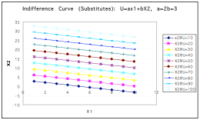
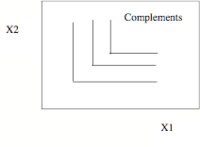
Substitutes would be represented by :

where the slope of the indifference curve would be = -a/b.
In graphic terms substitutability is greater the more the indifference curves approach a straight line. Perfect substitutability is a straight line indifference curve (e.g. trips to work by mode A or mode B).
Complements are represented by:

The more complementary the more the indifference curves approach a right angle curve; perfect complementarity would have a right angle indifference curve (eg. left and right shoes, trips from home to work and work to home)
Trade Game
The trade game is a way of examining how economic trading of resources affects individual utility. Imagine the economy consists of the following resources (denoted by colored slips of paper)
- White
- Purple
- Brown
- Orange
- Blue
- Gray
- Green
- Yellow
- Gold
The objective of the game is to maximize your gains in utility.
Define A Utility Function for Yourself

You are handed an assortment of resources
Measure your utility
Trade with others in the class (15 minutes) Record your trades.
At the end of the trading period measure your utility again. Compute your absolute and percentage increase.
Record scores on the board
Discuss
Is there a better way to allocate resources?
Preference Maximization
Graphical
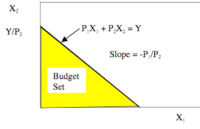

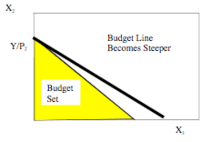
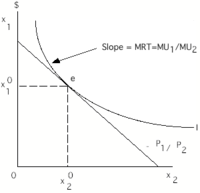
Utility maximization involves the choice of bundles under a resource constraint. For example, individuals select the amount of goods, services and transportation by comparing the utility increase with an increase in consumption against the utility loss associated with the giving up of resources (or equivalently forgoing the consumption which those resources command).
Often one price is taken to be 1, and one good is taken to be money. An income increase can be represented by the outward movement of the budget line.
An increase in the price of good  can be represented by a change in the slope of the budget line (still anchored at one end).
can be represented by a change in the slope of the budget line (still anchored at one end).
In graphic terms the process of optimization is accomplished by equating the rate at which an individual is willing to trade off one good for another to the rate at which the market allows him/her to trade them off. This can be represented in the following graph
The individual maximizes utility by moving down the budget constraint to that point at which the slope of the budget line ( ) which is the rate of exchange dictated by the market is just equal to the rate at which the individual is willing to trade the two goods off. This is the slope of the indifference curve or the marginal rate of transformation (MRT). A point such as 'e' is an equilibrium point at which utility is being maximized.
) which is the rate of exchange dictated by the market is just equal to the rate at which the individual is willing to trade the two goods off. This is the slope of the indifference curve or the marginal rate of transformation (MRT). A point such as 'e' is an equilibrium point at which utility is being maximized.
Equilibrium is the tangency between the indifference curve/utility and the budget constraint.
Optimization
As an optimization problem, this can be written:

subject to:

 is in
is in 
where:
-
 = price vector,
= price vector, -
 = goods vector,
= goods vector, -
 = income
= income
(Because of non-satiation, the constraint can be written as px=m.) This kind of problem can be solved with the use of the Lagrangian:
 where
where
-
 is the Lagrange multiplier
is the Lagrange multiplier
Take derivatives with respect to  , and set the first order conditions to 0
, and set the first order conditions to 0

Divide to get the Marginal rate of substitution and Economic Rate of Substitution

Example: Optimizing Utility





Solving

or

substituting into the budget constraint:



Demand, Expenditure, and Utility
Indirect Utility
The Marshallian Demand relates price and income to the demanded bundle. This is given as  . This function is homogenous of degree 0, so if we double both
. This function is homogenous of degree 0, so if we double both  and
and  ,
,  remains constant. We can develop an indirect utility function:
remains constant. We can develop an indirect utility function:

subject to: 
where X that solves this is the demanded bundle
Example: Indirect Utility

taking a monotonic transform:

which increases in income and decreases in price
where the  that solves this is the demanded bundle
that solves this is the demanded bundle
Properties
Properties of the indirect utility function 
- is non-increasing in
 , non-decreasing in
, non-decreasing in 
- homogenous of degree 0
- quasiconvex in

- continuous at all

Expenditure Function
The inverse of the indirect utility is the expenditure function

subject to: 
Properties of the expenditure function  :
:
- is non-decreasing in

- homogenous of degree 1 in

- concave in

- continuous in
 for
for 
Roy's Identity
The Hicksian Demand or compensated demand is denoted h(p,u).

vary price and income to keep consumer at fixed utility level vs. Marshallian demand. Roy's Identity allows going back and forth between observed demand and utility

Example (continued)


Equivalencies
 the minimum expenditure to reach
the minimum expenditure to reach  is
is 
 the maximum utility from income
the maximum utility from income  is
is 
 Marshallian demand at
Marshallian demand at  is Hicksian demand at
is Hicksian demand at 
 Hicksian demand at
Hicksian demand at  is Marshallian demand at
is Marshallian demand at 
Measuring Welfare
Money Metric Indirect Utility Function
The Money Metric Indirect Utility Function tells how much money at price p is required to be as well off as at price level q and income m. Define it as

Equivalent Variation

note 1 indicates after, 0 indicates before
Current prices are the base, what income change will give equivalent utility
Compensating Variation
 New prices are the base, what income change will compensate for price change
New prices are the base, what income change will compensate for price change
Consumer's Surplus
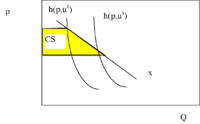

Generally

When utility is quasilinear ( , then:
, then:

Arrow's Impossibility Theorem
Arrow's Impossibility Theorem An illustration of the problem of aggregation of social welfare functions:
Three individuals each have well-behaved preferences. However, aggregating the three does not produce a well behaved preference function:
- Person A prefers red to blue and blue to green
- Person B prefers green to red and red to blue
- Person C prefers blue to green and green to red.
Aggregating, transitivity is violated.
- Two people prefer red to blue
- Two people prefer blue to green, and
- Two people prefer green to red.
What does society want?
Preferences
Consumption Bundles
Define a consumption set X, e.g. {house, car, computer},
'x', 'y', 'z', are bundles of goods, such as x{house,car}, y{car, computer}, z{house, computer}.
Goods are not consumed for themselves but for their attributes relative to other goods
We want to find preferences that order the bundles. Utility is ordinal, so we only care about which is greater, not by how much.
Conditions
There are several Conditions on preferences to produce a continuous (well-behaved) utility function.
- Completeness: Either
 (Read x is preferred to y) or
(Read x is preferred to y) or  or both
or both - Reflexive:

- Transitive: if
 and
and  then
then  (This poses a problem for social welfare functions)
(This poses a problem for social welfare functions) - Monotonicity: If
 then
then 
- Local Non-satiation: More is better than less
- Convexity: if
 and
and  then
then 
- Continuity: small changes in input beget small changes in output. The preference relation
 in X is continuous if it is preserved under the limit operation
in X is continuous if it is preserved under the limit operation
The function f is continuous at the point a in its domain if:
-
 exists
exists
If 'f' is not continuous at 'a', we say that 'f' is discontinuous at 'a'.
